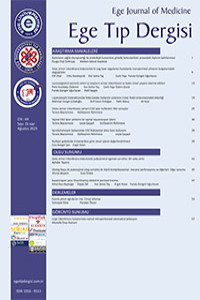Stres üriner inkontinans tedavisinde Er:yag lazer uygulanan hastalarda transperineal ultrason bulgularındaki değişiklikler
Abstract
Amaç: Stres üriner inkontinans öksürme, hapşırma, efor ve fiziksel egzersiz sırasında olan istemsiz idrar kaçırmadır. Yaşa bağımlı olarak prevalansı değişmekle birlikte (%29-75) ortalama % 48’dir. Lazer, tedavide uygulanan non invaziv yöntemlerden biridir. Bu çalışmanın amacı stres üriner inkontinansın tedavisinde lazer uygulanan hastalarda tedavi öncesi ve sonrası perineal ultrasonografi bulgularının değerlendirilmesidir.
Gereç ve Yöntem: Çalışmaya İstanbul Üniversitesi Tıp Fakültesi Hastanesi Ürojinekoloji polikliğinde stres üriner inkontinans nedeniyle Er:YAG lazer uygulanan 13 hasta çalışmaya dahil edildi. Yaş ortalaması 47.69 yıl (36-63), BMI=29.13 (21.7-39.3) idi.
Hastalara 1 ay aralıklarla olacak şekilde 3 seans üretral + vaginal Er: YAG lazer uygulandı. Tedaviye başlamadan ve tedavi bitiminin 3. ayında transperineal ultrasonografi ile mesane duvar kalınlığı, üretra uzunluğu, üretra duvar kalınlığı ve genital hiatus açıklığı değerlendirildi.
Bulgular: Tedavi sonrası mesane duvar kalınlığında azalma olduğu görüldü fakat anlamlı fark saptanmadı (p:0,245). Tedavi sonrası üretra uzunluğunun arttığı (p:0,002) ,üretra duvar kalınlık artışı olduğu (p:0,008) ve genital hiatus açıklığında daralma olduğu (p:<0,001) gösterildi ve bu veriler anlamlı olarak değerlendirildi.
Sonuç: Er:YAG lazer tedavisi öncesi ve sonrası transperineal ultrasonografi bulgularında stres üriner inkontinans etiyolojisine yönelik anlamlı değişiklikler görülmüştür. Mesane duvar kalınlığı urge üriner inkontinans ile ilişkili olup lazer tedavisi ile anlamlı değişiklik saptanmadı. Üretra uzunluğu ve üretra duvar kalınlığı artışları stres üriner inkontinansın önleyici mekanizmalarından olup lazer tedavisi ile anlamlı iyileşme görüldü. Genital hiatustaki daralma lazer tedavisinin pelvik taban kaslarını güçlendirerek inkontinansı önlediğini göstermektedir.
References
- Nygaard IE, Heit M. Stress urinary incontinence. Obstet Gynecol. 2004;104(3):607-620. doi:10.1097/01.AOG.0000137874.84862.94
- Abufaraj M, Xu T, Cao C, et al. Prevalence and trends in urinary incontinence among women in the United States, 2005-2018. Am J Obstet Gynecol. 2021;225(2):166.e1-166.e12. doi:10.1016/j.ajog.2021.03.016.
- Incontinence 7th Edition (2023). ICI-ICS. International Continence Society, Bristol UK, ISBN: 978-0-9569607-4-0.
- Conté C, Jauffret T, Vieillefosse S, Hermieu JF, Deffieux X. Laser procedure for female urinary stress incontinence: A review of the literature. Prog En Urol. 2017;27(17):1076-1083. doi:10.1016/j.purol.2017.09.003.
- Clinical significance of anatomical urethral length on stress urinary incontinence women Yu Seob Shin et al, Int J Womens Health ,2018 Jul 6:10:337-340.
- Inci Sema Tas, Cenk Yasa, Funda Gungor Ugurlucan, Alkan Yildirim. Association between Pelvic Floor Dysfunction and Pelvic Floor Ultrasonography Evaluation in Pregnant Women: A Cross-Sectional Study. Clin. Exp. Obstet. Gynecol. 2022, 49(9), 203.
- The pathophysiology of stress urinary incontinence in women and its implications for surgical treatment J O DeLancey, World J Urol, 1997;15(5):268-74.
Changes in transperineal ultrasound findings in patients with stress urinary incontinence treated with Er:YAG laser
Abstract
Aim: Stress urinary incontinence (SUI) is defined as the involuntary leakage of urine during coughing, sneezing, physical exertion, or exercise. Its prevalence varies with age (29%-75%), with an average of 48% (1-2). Laser is one of the non-invasive methods used in treatment (3). This study aimed to evaluate transperineal ultrasound findings before and after laser treatment in patients treated for stress urinary incontinence.
Materials and Methods: The study included 13 patients with stress urinary incontinence who underwent Er:YAG laser treatment at the Urogynecology Clinic of Istanbul University Faculty of Medicine Hospital. The mean age of the patients was 47.69 years (range: 36–63), and the mean BMI was 29.13 (range: 21.7–39.3). Patients received three sessions of urethral and vaginal Er:YAG laser treatments at one-month intervals. Bladder wall thickness, urethral length, urethral wall thickness, and genital hiatus width were evaluated with transperineal ultrasound before the treatment and at the third month following the completion of the treatment.
Results: After treatment, a reduction in bladder wall thickness was observed, but the difference was not statistically significant (p=0.245). A significant increase in urethral length (p=0.002), an increase in urethral wall thickness (p=0.008), and a reduction in genital hiatus width (p<0.001) were observed, and these findings were statistically significant.
Conclusion: Significant changes related to the etiology of stress urinary incontinence were observed in transperineal ultrasound findings before and after Er:YAG laser treatment. While bladder wall thickness, which is associated with urge urinary incontinence, did not show a significant change with laser treatment, the increases in urethral length and urethral wall thickness, mechanisms preventing stress urinary incontinence, showed significant improvement. The reduction in genital hiatus width indicates that laser treatment strengthens pelvic floor muscles and helps prevent incontinence.
References
- Nygaard IE, Heit M. Stress urinary incontinence. Obstet Gynecol. 2004;104(3):607-620. doi:10.1097/01.AOG.0000137874.84862.94
- Abufaraj M, Xu T, Cao C, et al. Prevalence and trends in urinary incontinence among women in the United States, 2005-2018. Am J Obstet Gynecol. 2021;225(2):166.e1-166.e12. doi:10.1016/j.ajog.2021.03.016.
- Incontinence 7th Edition (2023). ICI-ICS. International Continence Society, Bristol UK, ISBN: 978-0-9569607-4-0.
- Conté C, Jauffret T, Vieillefosse S, Hermieu JF, Deffieux X. Laser procedure for female urinary stress incontinence: A review of the literature. Prog En Urol. 2017;27(17):1076-1083. doi:10.1016/j.purol.2017.09.003.
- Clinical significance of anatomical urethral length on stress urinary incontinence women Yu Seob Shin et al, Int J Womens Health ,2018 Jul 6:10:337-340.
- Inci Sema Tas, Cenk Yasa, Funda Gungor Ugurlucan, Alkan Yildirim. Association between Pelvic Floor Dysfunction and Pelvic Floor Ultrasonography Evaluation in Pregnant Women: A Cross-Sectional Study. Clin. Exp. Obstet. Gynecol. 2022, 49(9), 203.
- The pathophysiology of stress urinary incontinence in women and its implications for surgical treatment J O DeLancey, World J Urol, 1997;15(5):268-74.
Details
| Primary Language | English |
|---|---|
| Subjects | Obstetrics and Gynaecology |
| Journal Section | Research Articles |
| Authors | |
| Publication Date | August 25, 2025 |
| Submission Date | February 7, 2025 |
| Acceptance Date | August 6, 2025 |
| Published in Issue | Year 2025 Volume: 64 Issue: Özel Sayı: 1 (11. Ulusal Ürojinekoloji Kongresi Bildiri Kitapçığı) |
Ege Journal of Medicine enables the sharing of articles according to the Attribution-Non-Commercial-Share Alike 4.0 International (CC BY-NC-SA 4.0) license.

